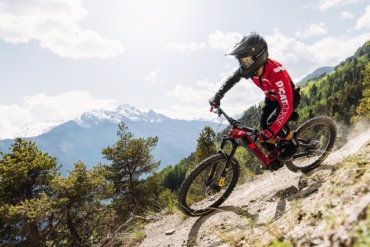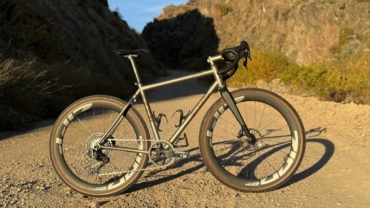Chains aren’t sexy or glamorous – at least in the context of cycling. No one ever asks, “What brand of chain are you running?” In the cyclist’s stream of consciousness on and off road, chains get barely a second thought.
Derailleurs, shifting systems, and cassettes score all of the glam. Yet those parts are useless without the chain. And a fresh high-end chain will enhance the performance of your bike more than a new $2,000 build kit in many ways.
Neglecting your chain will inhibit shifting performance in the short-term, resulting in a decline in overall efficiency. In the long-term, you might be facing a large parts bill for replacing the chain, cassette, and chainrings.
And the experts agree. “I think everyone could be better about chain maintenance,” said Darian Harvey, the head wrench at Mountain Bike Specialists. Harvey has represented the United States not only in the World Cup but also in the World Championships in Downhill. “Chain lubrication and replacement can save people a lot of time and money in the long run.”
So, what do you need to do to keep your links – and your bike – happy? Here are the basics you should know to care for your bike chain and diagnose problems.
Bike Chain Maintenance
A derailleur bicycle chain is made up of individual links. A link comprises two inner plates, two outer plates, two pins, and two rollers. It’s a simple and elegant assembly, the integrity of which depends on precise tolerances and exacting metallurgy.
Unfortunately, that precision piece of equipment lives in an environment of street crud, mud, fine dust, particulate matter, and water. All of those elements undermine the structural integrity of your chain. Thus, your first line of defense is to maintain a clean drivetrain.
Several manufacturers market cleaning kits that enable bike owners to clean their chain while it’s on the bike. Nothing, however, beats the full Monty of removing your chain for a good soak in cleaning solvent and a thorough cleaning of your cassette, chainrings, and derailleur(s).
Keeping your drivetrain clean results in less friction, less wear, and more efficiency (read: more enjoyment, faster times).
Chain Stretch: Why It’s a Problem
No matter how clean you keep your drivetrain, though, at some point a chain will need to be replaced. We’ve all heard that chains “stretch,” but what causes it?
Few companies have researched chains as much as the German company Wippermann. Founded in 1893, its main market involves heavy industrial applications and timing belts for high-performance German automobiles.
Tom Petrie works with Wippermann’s Connex brand bicycle chains. “Elongation of the chain is the result of the pins wearing against the inside surface of the inner link collars,” he told us. “As the pins wear, their diameter gets smaller. As the interior surfaces of the inner link collars wear, their diameter gets larger. The result: elongation.”
Elongation, by itself, is not a bad thing. However, you run into issues when one component of a system wears more quickly than others. And an elongated chain prematurely wears other components.
It also leads to a loss of shifting performance. If you’re having issues shifting into your lowest or highest gears, it could be time for a new chain.
How Chains and Chainrings Work
A new chain, on a new cassette or chainring, distributes force evenly across all surfaces. The cassette and chain are designed to mesh like a hand and glove. As your chain elongates, that’s disrupted.
“Instead of all the teeth on the chainring equally bearing the load, just the first few teeth bear the load,” Petrie said. “This is why you can lift a worn chain off the chainring at the 3 o’clock position. The same thing happens with cogs in the rear. When you’ve only got one tooth bearing most of the load, the ring or cog wears much more quickly than it does when the load is more evenly distributed across all the teeth.”
As chains wear, and as fewer surfaces take on more of the load, shifting performance will also suffer. According to Pedro Santos, engineering manager at SRAM’s partner chain factory and hardcore XC MTB racer, “As inner plate holes and pins wear, the chain play increases, increasing lateral and torsional play.”
What occurs is that there’s more force on a smaller surface. So you have to overcome those greater forces when shifting, leading to that wonky “it takes forever to get in gear” feeling.
When to Replace Your Bike Chain
How do you know when a chain is ready to be replaced? Mileage or time in the saddle won’t be a reliable metric for chain replacement.
Chain wear, and therefore drivetrain wear, will be a factor of applied force and cleanliness. Do you commute in the rainy PNW and rarely clean or lube your chain? Chances are you will have to replace your chain more frequently than someone who is meticulous about maintenance and lives in southern California.
Are you a criterium racer and throwing 1,100 watts of power out in a sprint? Chances are you will be replacing your chain more often than the rider who puts out 180 watts for hours at a time.
The only accurate way is to objectively measure with a gauge. Most chain gauges measure 0.75 and 1.0 percent of elongation. Most manufacturers state that, when the chain elongates from 0.8 to 1.0 percent of its original length, chains will be out of spec and drivetrain wear will be accelerated. That spec is manufacturer dependent. It’s prudent to shoot for a maximum elongation of 0.75 percent, determined using a chain gauge.
Choosing a New Bike Chain
Price
When choosing a new chain, you definitely get what you pay for.
“As we go up on the chain hierarchy, chains are lighter weight, have better finishes for corrosion and wear resistance,” said Pedro Santos, a representative from SRAM’s partner factory.
If you ride a lot, spend the money upfront for a higher-end chain. That higher price buys you pins that are highly polished, with closer tolerances, and, in some cases, are boron heat treated.
This investment buys much closer consistency of inner link collar diameter. We’re talking about a difference of 5 micrometers for a standard replacement chain to 1 micrometer for a high-end upgrade – or 80 percent closer tolerances. Those closer tolerances eliminate high spots on pins and deformities on the inner link collar, all of which translates into less wear.
Out of the shop, a budget chain and a pro level chain will ride very similarly. However, three, six, or 12 months down the road is where the investment pays off.
Brand
Finally, when selecting a brand, keep in mind that your chain does not have to match the brands of your derailleur(s) and cassette. Chain specs are governed by a variety of industry standards and have to meet predetermined criteria within a category. A brand that insists that you use its chain for best performance wants to sell you more of its products and keep the money in the family.
And for many brands, when they create a high-end build kit or groupset, they cheap out on chain material and tolerances. This a good place to strip costs because, as noted, chains are not sexy.
Not into the investment or maintenance? I hear you.
No, I mean I can really hear you. Your dry chain is squeaking. I hear the grind in your drivetrain that sounds like you have a bag of rocks in there. And those sounds are robbing you of efficiency and enjoyment.
A new chain will result in better all-around performance. And that boost won’t require needles, mail-order packages from a foreign country, or clandestine visits in the dark of night. Just a visit to your local bike shop.










